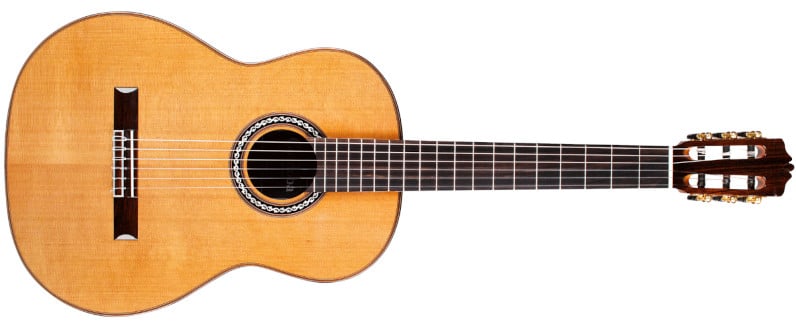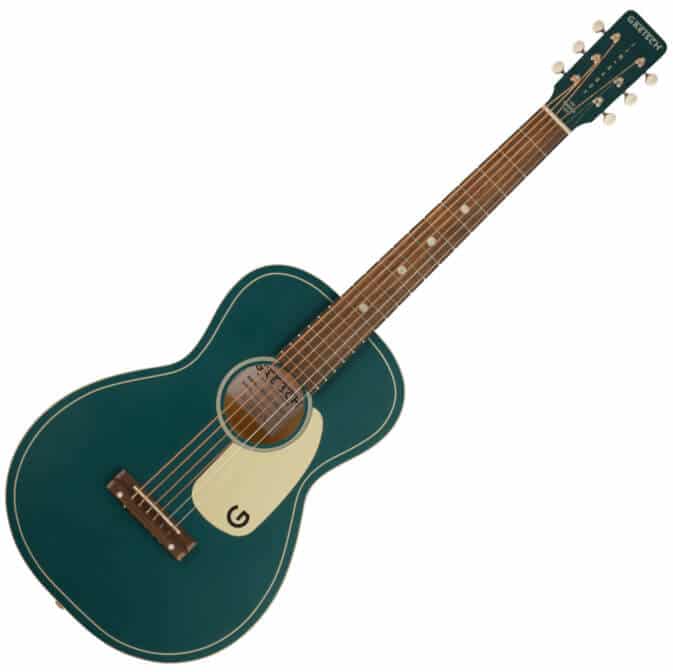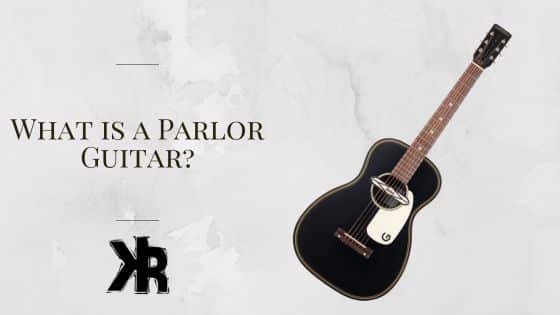Table of Contents
The parlor guitar holds a special place in history, but also with musicians who appreciate its custom characteristics.
The parlor guitar, known for its smaller body size and warm, intimate sound, originated in the 19th century and was a popular instrument for home entertainment.
Despite a decline in popularity during the 20th century, parlor guitars have experienced a resurgence in recent years. This is all thanks to the growing interest in singer-songwriters and folk music.
This Killer Rig article will explore the features of parlor guitars, their rich history, and the notable musicians who have embraced this charming instrument. But also provide guidance for those interested in adding a parlor guitar to their collection.
What is a Parlor Guitar?
A parlor guitar is a type of acoustic characterized by its smaller body and shorter scale length. This design offers a playing experience and sound that has made it a popular choice among both novice and experienced musicians.
Ideal for new players or those with limited knowledge of guitar types. Parlor guitars are known for their pronounced midrange and quick decay. Making them well-suited for fingerstyle playing, blues, folk, and singer-songwriter genres.
Their compact size not only provides an intimate sound, but also makes them more comfortable to hold and play. Especially for those with smaller hands or who prefer a lighter instrument.

Characteristics of Parlor Guitars
When it comes to parlor guitars, there are a few key features that make them stand out from the crowd.
Compact Body Size
Parlor guitars are known for their smaller, lightweight design that typically measures between 36 and 40 inches in length.
They have a narrower waist and a more rounded lower bout compared to other guitar types like dreadnoughts and jumbos. This smaller size offers several benefits, such as:
- Easier handling and transportation, making them popular among traveling musicians.
- Greater comfort and playability, especially for fingerstyle guitarists or those with smaller hands.
- A more intimate connection between the player and the instrument, resulting in a unique playing experience.
Sound
Despite their smaller size, parlor guitars produce a warm and intimate sound, thanks to their compact body that emphasizes midrange and high frequencies.
This well-balanced tone, combined with a clear and articulate voice, makes them perfect for accompanying vocals or playing solo pieces.
The tonal qualities of parlor guitars also make them ideal for fingerpicking styles, as they are responsive to a light touch and emphasize the nuances in a player’s technique.
But you can use a parlor for many other styles of music including soul, jazz, mariachi and even punk!
Classic Aesthetics and Customization Options
Parlor guitars often feature a classic, vintage appearance that harkens back to their 19th-century origins. Many models include intricate inlays, ornate rosettes, and beautifully crafted bindings, giving them a timeless and visually appealing design.
For those looking to personalize their instrument, many manufacturers offer customization options such as tonewood, finish, and hardware choices.
This allows players to create a specific parlor guitar that reflects their individual style and preferences.
The History of Parlor Guitars
Understanding the history of parlor guitars is essential to appreciate their timeless charm.
Origins in the 19th Century
Parlor guitars date back to the 19th century. A time when musical trends and home entertainment played a significant role in their development.
As the name suggests, these guitars were often played in parlors. These are small, intimate rooms where families and friends would gather to enjoy music.
Parlor guitars became a popular choice for these gatherings due to their manageable size and pleasant sound.
Decline in Popularity in the 20th Century
As musical tastes evolved and larger instruments gained prominence, the popularity of parlor guitars began to wane.
The 20th century saw the rise of guitars like the dreadnought, which offered more volume and projection. They were better suited for larger venues and ensemble performances.
Consequently, parlor guitars took a back seat as musicians gravitated towards bigger and louder instruments.
The Modern Revival
In recent years, parlor guitars have experienced a resurgence in popularity. This is largely driven by the growing interest in singer-songwriters, folk music, and the desire for a more intimate sound.
Modern musicians, particularly those in the indie and folk scenes, have embraced parlor guitars for their special tonal qualities and vintage aesthetic.
As a result, both well-established and boutique guitar manufacturers have started producing them once again. Catering to the demands of a new generation of musicians.

Famous Parlor Guitar Players
Parlor guitars have been played by many influential musicians, both past and present. Here, we’ll highlight some of the artists who have made their mark with parlor guitars, showcasing the instrument’s versatility and charm.
- Robert Johnson: One of the most celebrated Delta blues musicians, Robert Johnson was known for his mastery of the parlor guitar. His haunting and emotive playing style, combined with the sound of his parlor guitar, helped shape the blues genre. He influenced countless musicians in the decades that followed.
- Eric Clapton: A legendary guitarist and singer-songwriter. Eric Clapton has been known to play parlor guitars throughout his career. His affinity for blues music and fingerpicking techniques make the parlor guitar a fitting choice for his expressive playing style.
- Mark Orton: An accomplished composer and guitarist. Mark Orton often incorporates parlor guitars into his scores and performances. His work with the band Tin Hat Trio and his film scores showcase the unique sound and character of the parlor guitar.
- Ed Sheeran: A popular singer-songwriter. Ed Sheeran has played parlor guitars on occasion, taking advantage of their intimate sound to accompany his heartfelt lyrics and memorable melodies.
- John Mayer : A versatile musician known for his work in pop, blues, and folk genres. John Mayer has been known to perform with parlor guitars, taking advantage of their special sound qualities and classic look.
Choosing the Right Parlor Guitar for You
Selecting the ideal parlor guitar for your needs and preferences can seem overwhelming due to the vast range of options available on the market.
Sound and Appearance
The type of wood used for the guitar’s top, back, and sides can significantly impact the instrument’s sound and appearance. Common tonewoods for parlor guitars include spruce, cedar, mahogany, and rosewood.
You will find that spruce and cedar are brighter sounding, while mahogany and rosewood will be warmer. Some companies also make them from carbon fiber, which have a brighter tone character.
Each wood has its own tonal characteristics. So understanding how the choice of tonewood aligns with your desired sound is essential.
Finding the Perfect Price Range
Parlor guitars come in various price ranges, from affordable entry-level models to high-end, custom-built instruments. Determine your budget before shopping.
Remember that while a more expensive guitar may offer better craftsmanship and materials, an affordable model can still provide a satisfying playing experience.
The table below will provide you with a few examples of popular parlor guitars and their prices.
| Parlor Guitar | Price |
|---|---|
| Fender CP-60S | $199.00 |
| Alvarez AP66SHB | $429.00 |
| PRS SE P20E | $499.00 |
| Epiphone J-200 | $549.00 |
Choosing Between New and Vintage Guitars
Both new and vintage parlor guitars have their appeal. New guitars may offer modern construction techniques, better playability, and warranty protection.
While vintage guitars can provide a unique charm and historical value. Consider whether you’re interested in a brand-new instrument or a piece of history when making your choice.
Evaluating Neck and Playability
The neck’s width, profile, and fretboard radius can significantly impact the guitar’s playability.
Make sure to try various neck profiles and configurations to find the one that feels most comfortable for you. Especially if you have smaller hands or a specific playing style.
Considering Manufacturer Reputation
Research different guitar manufacturers and get feedback from other players. Look for companies with a solid reputation for producing high-quality parlor guitars. Take note of any recurring issues or concerns raised by other musicians.
Conclusion
When choosing the right parlor guitar, it’s essential to consider factors such as tonewood, price range, and manufacturer reputation.
By carefully evaluating these aspects and trying out different models, you can find the perfect instrument that aligns with your musical style and preferences.
Whether you’re a seasoned musician seeking a specific sound or a beginner exploring the world of guitars. The parlor guitar offers an unparalleled intimate playing experience.
FAQs
What are the differences between a parlor guitar and a full-sized acoustic?
A parlor guitar is smaller and more compact than a full-sized acoustic. The most noticeable differences include a smaller body, shorter scale length, and a narrower waist. These features contribute to the parlor guitar’s sound.
Characterized by a pronounced midrange and a quicker decay. Due to their size, parlor guitars are also more comfortable to play for small people or those looking for a more manageable instrument.
Are parlor guitars suitable for beginners?
Yes, parlor guitars can be an excellent choice for beginners. Their smaller size and shorter scale length can make them more comfortable and easier to play. Particularly for individuals with smaller hands or younger players.
Additionally, their sound and versatility across various musical styles can provide an engaging and enjoyable learning experience for new musicians.
Can I use a parlor guitar for live performances and recording?
Yes, parlor guitars are suitable for both live performances and recording sessions. Their specific sound and intimate tonal qualities can add depth and character to your music. This makes them an excellent choice for various settings.
For live performances, you can either use a microphone to capture the guitar’s natural acoustic sound or install a pickup system to amplify the instrument.
In recording sessions, parlor guitars can provide a specific sonic texture that complements other instruments and vocals. Making them a valuable addition to your musical tool kit.

